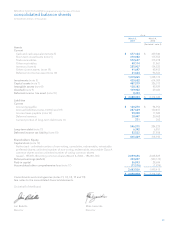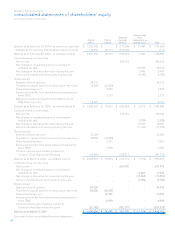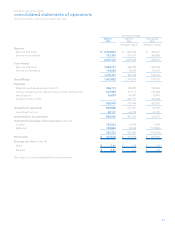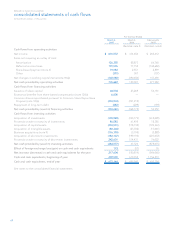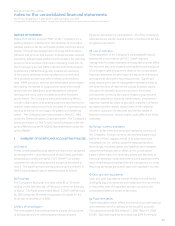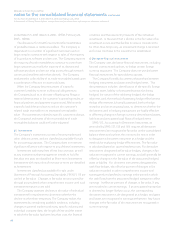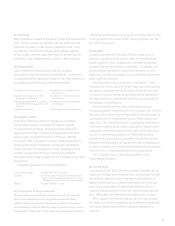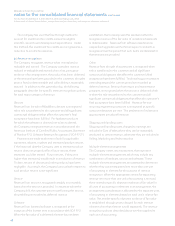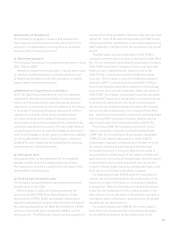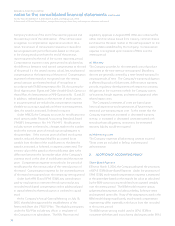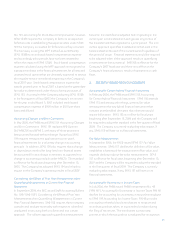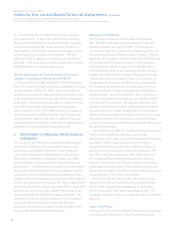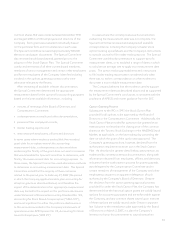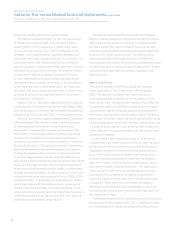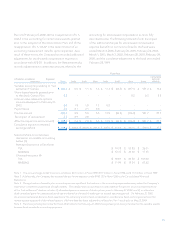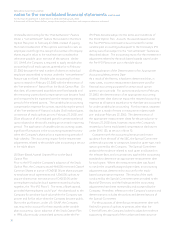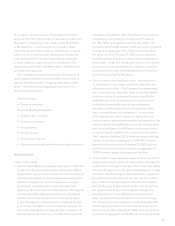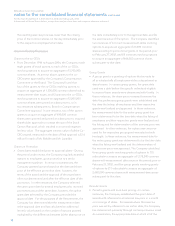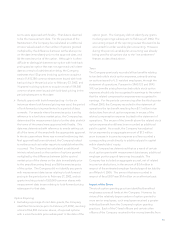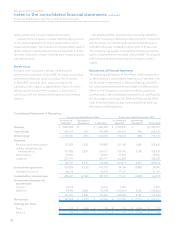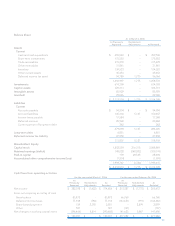Blackberry 2007 Annual Report Download - page 73
Download and view the complete annual report
Please find page 73 of the 2007 Blackberry annual report below. You can navigate through the pages in the report by either clicking on the pages listed below, or by using the keyword search tool below to find specific information within the annual report.71
No. 123, Accounting for Stock-Based Compensation, however,
SFAS 123(R) requires the Company to factor in an expected
forfeiture rate in establishing the expense while under SFAS
123 the Company accounted for forfeitures as they occurred.
The Company is using the MPT method as permitted by
SFAS 123(R) to record stock-based compensation expense
and accordingly prior periods have not been restated to
reflect the impact of SFAS 123(R). Stock-based compensation
expense calculated using the MPT approach is recognized on
a prospective basis in the financial statements for all new and
unvested stock options that are ultimately expected to vest as
the requisite service is rendered beginning in the Company’s
fiscal 2007 year. Stock-based compensation expense for
awards granted prior to fiscal 2007 is based on the grant-date
fair value as determined under the pro forma provisions of
SFAS 123. As a result of the Company adopting SFAS 123(R)
in the first quarter of fiscal 2007, the Company’s net income
for the year ended March 3, 2007 included stock-based
compensation expense of $18.8 million or $0.10 per share
basic and diluted.
Accounting Changes and Error Corrections
In May 2005, the FASB issued SFAS 154 Accounting Changes
and Error Corrections. SFAS 154 replaces APB Opinion
20 (“APB 20”) and SFAS 3, with many of those provisions
being carried forward without change. If practical, SFAS
154 requires retrospective application to prior year’s
financial statements for a voluntary change in accounting
principle. In addition, SFAS 154 also requires that a change
in depreciation method for long-lived non-financial assets
be accounted for as a change in estimate, as opposed to a
change in accounting principle under APB 20. The standard
is effective for fiscal years beginning after December 15,
2005. The Company has adopted SFAS 154 and it had no
impact on the Company’s operating results in fiscal 2007.
Considering the Effects of Prior Year Misstatements when
Quantifying Misstatements in Current Year Financial
Statements
In September 2006, the SEC issued Staff Accounting Bulletin
No. 108 (“SAB 108”) Considering the Effects of Prior Year
Misstatements when Quantifying Misstatements in Current
Year Financial Statements. SAB 108 requires that a company
consider and evaluate materiality with respect to identified
unadjusted errors using both a rollover and iron curtain
approach. The rollover approach quantifies a misstatement
based on the identified unadjusted item originating in the
current year income statement and ignores any portion of
the misstatement that originated in a prior period. The iron
curtain approach quantifies misstatements that exist in the
balance sheet at the end of the current period regardless of
the period of origin. Financial statements would be required
to be adjusted when either approach results in quantifying
a misstatement that is material. SAB 108 is effective for the
Company’s 2007 fiscal year and there is no effect on the
Company’s financial position, results of operations or cash
flows.
3. RECENTLY ISSUED PRONOUNCEMENTS
Accounting for Certain Hybrid Financial Instruments
In February 2006, the FASB issued SFAS 155 Accounting
for Certain Hybrid Financial Instruments. SFAS 155 amends
SFAS 133 and among other things, permits fair value
remeasurement for any hybrid financial instrument that
contains an embedded derivative that otherwise would
require bifurcation. SFAS 155 is in effect for fiscal years
beginning after September 15, 2006 and the Company will
be required to adopt the standard in the first quarter of fiscal
2008. The Company is currently evaluating what impact, if
any, SFAS 155 will have on its financial statements.
Fair Value Measurements
In September 2006, the FASB issued SFAS 157 Fair Value
Measurements. SFAS 157 clarifies the definition of fair value,
establishes a framework for measurement of fair value, and
expands disclosure about fair value measurements. SFAS
157 is effective for fiscal years beginning after December 15,
2007 and the Company will be required to adopt the standard
in the first quarter of fiscal 2009. The Company is currently
evaluating what impact, if any, SFAS 157 will have on its
financial statements.
Accounting for Uncertainty in Income Taxes
In July 2006, the FASB issued FASB Interpretation No. 48
(“FIN 48”) Accounting for Uncertainty in Income Taxes. FIN 48
clarifies the accounting for uncertainty in tax positions subject
to SFAS 109 Accounting for Income Taxes. FIN 48 provides
a recognition threshold and a mechanism to measure and
record tax positions taken, or expected to be taken during
the filing of tax returns. The mechanism is a two-step
process in which the tax position is evaluated for recognition


